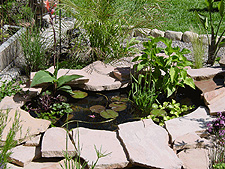
Water Plants
Water plants are essential to creating a healthy ecosystem in your pond. They provide oxygen to the water for your fish, and also provide coverage and hiding places for fish and other pond life. The root systems also provide a safe harbor for fish and other eggs. Types of water plants:
When adding plants to your pond, remember not to overcrowd them. Here is a guide to help you determine how many of each specific plant type can be added to each 10 square feet of your pond surface:
You can combine these different types of plants into each 10 square feet of surface space. Special baskets are made in various shapes and sizes for planting pond plants. Remove the plants from the container they come in when purchased, and plant in these baskets using specially formulated aquatic compost that is low in phosphorous and nitrogen. Pond plants should also be fertilized, but only with fertilizers specifically designed for water plants.  Fish & Other Pond Life | Maintaining Your Pond | FAQs | Contact Us |


